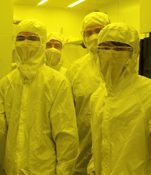Facilities
Our numerous capabilities provide a variety of on-site collaborative research opportunities

- At UNC Charlotte, we have structured our research activities to benefit from and offer value to industrial partners.
- Our public/private orientation allows us to provide numerous options and flexibility to partnering companies.
- Interaction between the university and industry ranges from sponsoring students as research assistants to partnering with UNC Charlotte in the construction of dedicated research facilities. Our numerous optoelectronics research capabilities provide a variety of on-site collaborative research opportunities. We also began to expand our capabilities for the characterization of biological samples.
CleanRoom Facility
A class 100 clean room is available for all micro- and nano-optics fabrication requirements. A portion of the facility will be class 1000 for experimental work with less stringent requirements. Total clean room space is approximately 3,000 sq. ft. The clean room includes necessary facilities, such as advanced lithography and processing, for the fabrication of complex optoelectronic devices and integrated circuits, including a Molecular Imprint Inc. Imprio 100 nanoimprint tool. High purity water is provided by a recirculating deionized system. Purge and process gases are plumbed throughout the facility.
CleanRoom Facility Access Fees (revised 08-19-10)
NanoFabrication Facility Safety and Standard Operating Procedures Manual
Optoelectronic and Optical Device Fabrication Facility
Optoelectronic components and sub-assemblies are the building blocks of almost all appliances we use today. The backbone and the front end of contemporary data-com and telecom equipment, systems, and networks all utilize devices such as photodetectors, semiconductor lasers, light-emitting diodes, waveguides, optical fibers, photonic crystal circuits, micro-switches, etc. The fabrication of such devices with added functionality and intelligence requires the integration of processes that combine microelectronics, micro-optics, and quantum phenomena on the microscopic and nanoscale level. The Center, as part of its mission, will develop new materials, novel devices, integration, and packaging process technology. As part of such an effort, the fabrication facility will be a key part of the Center’s program, where faculty, graduate students, and post-doctoral fellows will conduct research to implement and test innovative concepts and ideas. In turn they will acquire new expertise and training to develop new optoelectronic devices and subassemblies. Equipment in the Optoelectronic and Optical Device Fabrication Facility will include a rapid sol-gel system, sub-micron precision mask alignment system, and reactive ion-etching systems.
Optical Characterization and Measurement Facility
Applications and the range of usefulness of optical materials and devices are determined by many parameters that need to be established before the materials can be used in any device development. The primary goal of the Optical Characterization and Measurement Facility is to use dedicated analytical instruments to allow researchers to test and measure major optical properties by destructive and non-destructive methods. These properties include surface morphology, crystal structure, purity, diffusion depth, and index distribution. The facility will contain dedicated experimental stations to determine optical coefficients of material and devices including optical gain, loss, quality factors, and other optical constants. The laboratory will house instruments to measure electro-optic, magneto-optic, acousto-optic, transmission, absorption, and nonlinear factors. Such characterization will be used to evaluate and establish the limitation and usefulness of materials for optical applications and is essential for the development of any new optical devices.
Optical Communication Infrastructure Facility
Optical communication techniques, including fiber optics and lasers, are the workhorses of the Internet and high-capacity computing. Meeting the computing and telecommunications needs of the next two decades will require advances across a broad front of R&D, including optical signal generation, transmission, switching and routing, data storage and displays, and intelligent and seamless networking. Although institutions and companies have access to such rapidly growing, high-speed global telecommunication networks, the infrastructure is not yet in place to provide the individual user access that fully exploits the power of light. Additional research is necessary to be able to further develop optical communications at cost effective and high reliability levels. The Optical Communications Infrastructure Facility will include tunable communication laser systems, fiber fusion splicing systems, network analyzers, optical spectrum analyzers, optical fiber measurement and characterization systems, optical polarization analyzers, and supporting instrumentation and subsystems. We also have a dedicated research fiber network connecting our Center to our CMOT partners (WCU and Clemson).
Optical Metrology Facility
Optical metrology is a broad, enabling technology spanning large machine vision systems used for on-line inspection of manufactured parts and the determination and characterization of physical features at the micron and sub-micron level. UNC Charlotte already operates the leading university precision metrology laboratory in the U.S., and one of the leading laboratories in the entire world. This facility will significantly extend those capabilities. Optical metrology will continue to enable advances in communication, electro-optics, and information technology as well as increase the quality and capability of more familiar products like automobiles and aircraft. The Optical Metrology Facility will include the following instrumentation together with supporting database systems: scanned probe microscope system, AFMs, scanning near-field microscope, scanning laser confocal microscope, scanning electron microscope, and x-ray interferometer test stand.
Biologics Characterization Facility
A complete biophysical characterization can address modifications of the biological product that occur during the manufacturing process resulting in altered efficacy, toxicity, immunogenicity, and stability of the product. We are building analytical instrumentation capabilities for the characterization and analysis of biological molecules and their complexes. Currently, the facility offers circular dichroism (CD) technology that is designed for high sensitivity measurements in the near- and far-UV regions and used to determine the optical isomerism and secondary structure of molecules. CD is best suited for applications such as protein conformational studies, quantitative analysis of pharmaceuticals, formulation studies, analysis of complex formation, drug and ligand binding, enzyme kinetics studies, and purity testing of optically active substances.